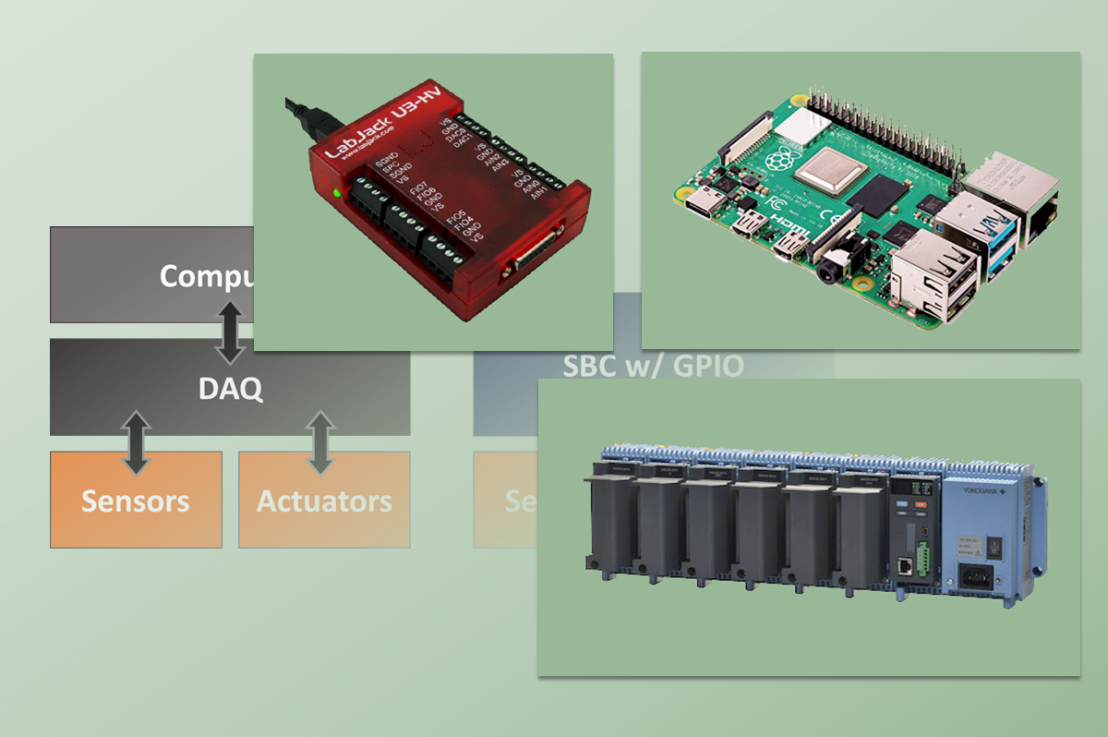DAQs, SBCs, Embedded Systems, and computers. How do they all fit together? Let’s first spell out the acronyms: DAQ stands (surprisingly) for Data Acquisition in general. It includes the software and hardware side of things. For this discussion, let’s stick to the hardware side. SBC stands for Single Board Computer. Something like your PC, but where everything that’s inside the box is on one single integrated circuit board. Furthermore, the SBCs we are interested in also have GPIO (General Purpose Input and Output), which we’ll get to later.
When we talk about data acquisition (in the broader sense) and automation, we are looking to interface the real world with a digital system, through sensors and actuators. Information will be collected or sensed from the real world, some sort of analysis or decisions will be made, and if we are doing automation, an action will be taken back into the real world.
As illustrated below, there are mostly three ways to put all the pieces together. Starting from the left, the most flexible, and usually most expensive arrangement, is a computer running on top of a DAQ device. In this type of application, it’s important to be able reconfigure your system to whatever your data acquisition needs are. A lab is usually where you will find this type of system, where the accuracy of what you’re measuring also plays a big role. A short list of DAQ devices should include LabJack, National Instruments and Yokogawa.

In the middle are the SBCs. Usually far less powerful than your computer, but still a fully functional computer. The SBCs of interest to us are the ones that also have GPIO pins. These General Purpose Input and Output pins enable a connection between the sensors/actuators and the software in the computer interacting with them. They are very cost-friendly and are used in education or in DIY projects, where accuracy and reliability are less critical. Also, the SBCs will mostly handle only digital signals. Any conversion from the real world analog signal to something the SBC can understand has to happen in the sensor or a separate ADC (Analog-to-Digital Conversion) component. Most DAQs, on the other hand, have the capability to handle both digital and analog signals, doing the needed conversions and providing the computer with a signal it can understand. A popular example of an SBC is the Raspberry Pi.
On the right hand side of the figure are the embedded systems, which by the way, are all around us. From the very sophisticated automotive ones (engine control units, transmission controllers, etc.) to the less glamorous ones, like the one in your dishwasher, these are dedicated computers, or more specifically micro-processors that only do one group of tasks and are designed to work with a specific set of sensors and actuators. They are more cost effective due to mass production and some of them are extremely fast, performing real-time calculations so all the actuation decisions can be made on-the-go. Depending on the application, reliability is quite critical. You don’t want the micro-processors in that air plane having to be rebooted amid flight. A good example of a very affordable embedded system is the Arduino.
A note on speed
When it comes to collecting data, it’s not uncommon to have an execution loop in the code that controls the acquisition. That is especially the case with automation. The tasks within an execution loop can be primarily grouped into either computations or I/O. The first group contains all activities where some processing of the data is done. The second group is where the inputs from and outputs to the real world are occurring, through a DAQ device or built-in I/O.

How fast an execution loop can run depends on how fast the tasks within each of those two groups can run. To some extent, it will come down to the hardware that’s being used for either the computation or the I/O. Let’s not forget that the number of data channels that are being handled is also an important factor. The better (and usually more expensive) the hardware, the faster it can run. Generally speaking, a computer with a DAQ device should have no problem with the computation part but may be held back by the DAQ device I/O.
On the other end of the spectrum, an embedded system, due to cost constraints, doesn’t have the computing power of a regular PC and may face some limits on how many computations can be performed. That is an important aspect, especially because these types of systems are used in real-time applications. The time it takes to get the sensor input data, do computations, and set the output actuator data (for one execution step) has to fit within the time frame of what’s happening with the real world that the embedded system is interacting with.
In terms of numbers (depending on complexity of calculations, hardware, sensors, and number of channels), a computer with a DAQ device should be able to run execution loops in the 10 to 100 Hz range. SBCs, which have the built-in I/O, can bring that number to 200 Hz or more. Embedded systems are all over the execution frequency range. Remember: they have to do the real-time task they’re designed for in the most cost-effective and reliable way possible. Real-time requirements for an autonomous vehicle are not the same as the ones for the thermostat controlling the temperature in your home.


Well, thank you Joao Silva! Stay tuned. Coming up are a post on doing analog-to-digital conversion with a Raspberry Pi, and a post on an example of fuel flow measurement using a LabJack.